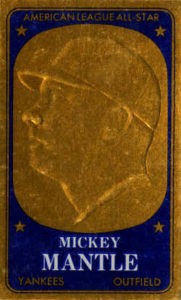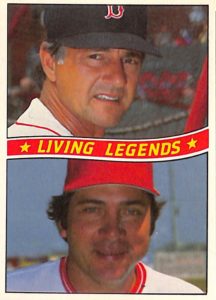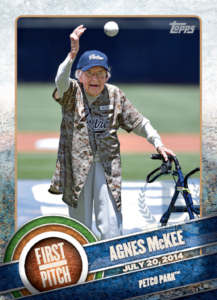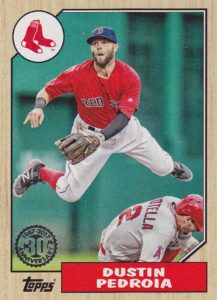Baseball Cards 102: Insert Cards
The first time I remember receiving an insert card in a baseball card wax pack was in 1965. That was the year I bought my first box of cards. I remember instantly disliking them and thinking they were the ugliest cards I ever saw. And they were, at least until the 1995 Fleer baseball cards came along, but I’ll save that for a future post. Our business today pertains to insert cards. Insert cards are those cards that are randomly inserted into baseball card packs.

The 1965 Topps insert set featured portraits of the best players of the era, with a total of 72 players included in the set. Back then you had to buy a lot of packs or trade a bunch of cards with your pals to put together the complete set. American League players had a blue background, and National League players had a red background. On the right is the Mickey Mantle card from the set.
Other inserts were issued in a variety of forms during the next several years. I remember deckle edged black and white cards, posters of individual players, scratch off games and little booklets featuring the life story of star players. In time I stopped buying packs altogether. I still loved baseball but was no longer an active collector.
In 1979 I started to miss the baseball cards of my youth, and one day I stumbled into King’s Baseball Cards. The Berkeley, California baseball card purveyor was conveniently located on the BART line, so I became a customer. At King’s, and other card stores like it, I could buy packs as well as individual cards from previous years. By early 1982 I was back in the hobby in a big way, so I was on hand to witness what was to become the next insert card that I would remember.

In 1984 Donruss issued a near-complete set, but there were two insert cards that year that collectors felt compelled to procure if they wanted to remove the “near” from the “complete.” Two “Living Legends” cards were excluded from the factory-issued set and could only be found in wax packs. I remember many collectors wanted these cards. The “A” card featured Rollie Fingers and Gaylord Perry. The “B” card, seen on the left, presented Johnny Bench and Carl Yastrzemski. Each of these four Hall of Fame players finished their careers in 1983, and when these insert cards were issued in 1984, the honor seemed very appropriate. It still does.
The insert cards that I’ve shown were from a far more simple time, when random insert cards were like little bonuses, sort of like the little toy you would get in the box of Cracker Jacks. But somewhere along the line insert card collecting started to change. Insert cards grew in importance as the baseball card market heated up in the 1980’s. Fleer and Donruss entered the market in 1981. Sportsflics came along in 1986. Score’s first set debuted in 1988. Upper Deck’s rookie issue surfaced in 1989. By 1990 Topps faced serious competition. Each company was looking for an edge in order to increase its sales, and insert cards helped. A baseball card boom was on.
But card manufacturers issued too many brands, too many sets and too many cards and over the years the public’s demand for them waned. Today Topps has the lion’s share of the market. Interest in insert cards remained strong however, and Topps along with a few small competitors issue them in bunches. But what was once a trickle is now a flood. An explosion of interest has transported the once humble insert card to the top of the current baseball card hierarchy. Insert cards rule!

So far, I count four types of insert sets in Series 1. On average, you’ll receive one of each type of insert card for every eight packs that you purchase. One of them is called First Pitch, and it’s a returning series from 2015 and 2016. When notable people and celebrities throw out the ceremonial fist pitch before a game, Topps is often there to capture the moment and put it on one of these cards. Past subjects included Rocker Eddie Vedder at Wrigley Field, Actor Jeff Bridges at Dodger Stadium, Rapper 50 Cent at Citi Field and Golfer Jordan Spieth at Fenway Park. My favorite First Pitch card is of 105-year-old Agnes McKee in action at Petco Park.
New this season are three other insert sets. Bowman Then & Now presents presents two photos of a current player on each card, one photo of his Bowman rookie card from many years ago and a second photo of that player today (Bowman is another one of the Topps brands). The Five Tool insert set contains the best of the best, those very special players who possess all of baseball’s five tools, which are to hit, hit with power, run, throw and field, that a player needs to excel in major league baseball.

Another insert set celebrates the 30th Anniversary of the 1987 Topps issue, whose cards are notable for their wood-finish design. Notable players past and present are presented on a card in the 1987 format, with a 30th Anniversary emblem on each card. There are 100 cards in this insert set. If you attempted to build this set by buying packs you’ll have to purchase 800 of them. Each pack contains twelve cards, so you’re looking at 9,600 baseball cards. That’s a lot of baseball cards. Even then, you’ll probably receive duplicates of some of the cards in the set and still need additional cards to finish up.
I’m certain there are more insert card sets out there this season. There has to be more. In order to complete each insert card set a collector will need some cash, access to a computer to purchase some of them on Ebay, membership in Facebook baseball card trading groups to procure some more and proximity to an area with Baseball Card Shows where a few more will be found. Putting these sets together can be a daunting task.
But wait! There’s more! A lot more! In my next post I’ll discuss “parallel cards.”


Interesting read Grubby.
Thank you, Jeff. Next time we have lunch together I’ll bring a bunch of these insert cards to show you. Kindest Regards, Grub.